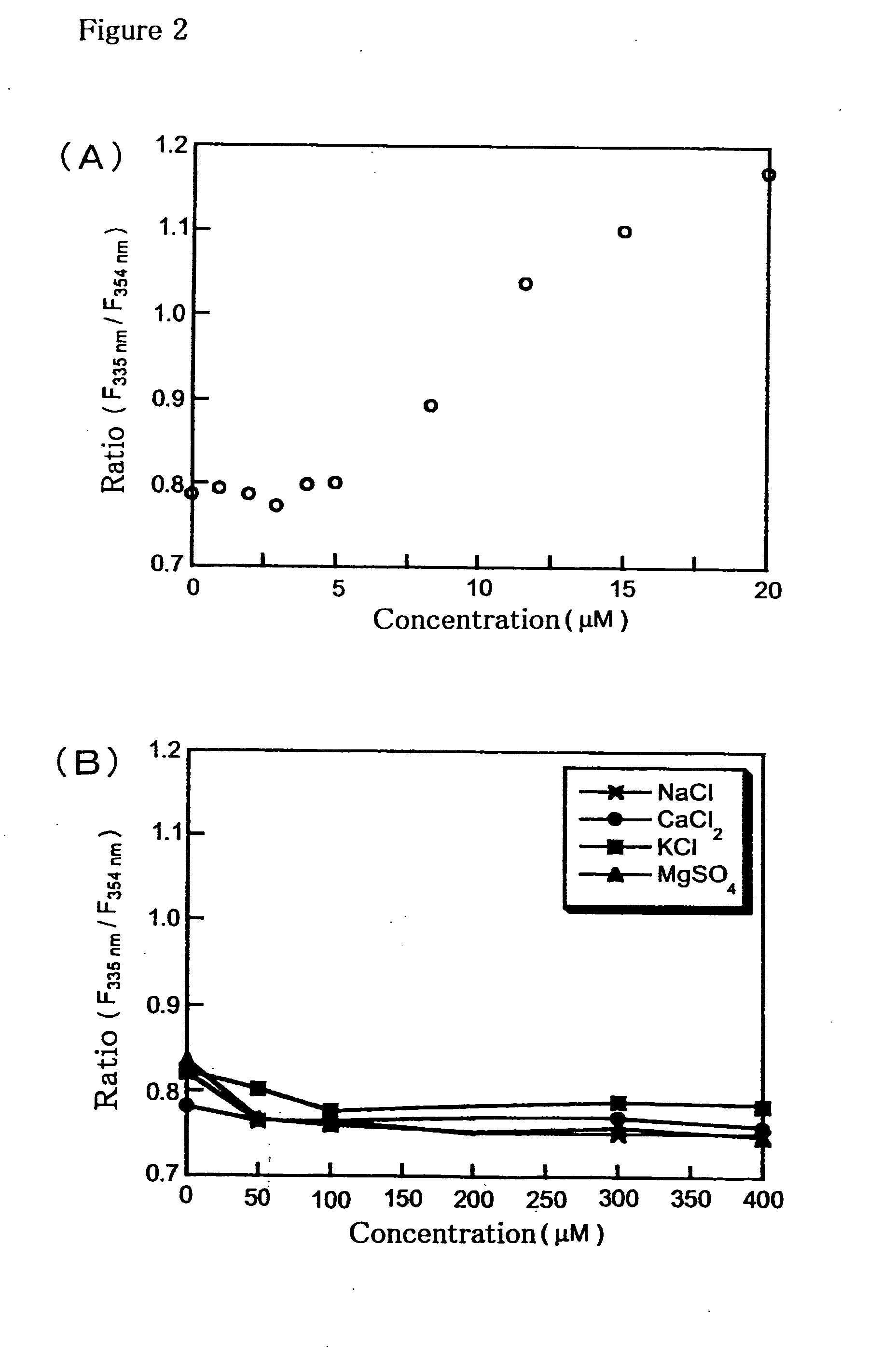Fluorescent probe for zinc
a fluorescent probe and zinc technology, applied in the field of fluorescence probes, can solve the problem that the ratio method has not been applicable for a precise measurement and achieve the effect of lowering increasing the concentration of intracellular zinc ions
- Summary
- Abstract
- Description
- Claims
- Application Information
AI Technical Summary
Benefits of technology
Problems solved by technology
Method used
Image
Examples
example 1
[0039]Compound (2) was prepared according to the method described in Journal of Organometalic Chemistry, 2000, 611, pp. 586-592. Compound (2) (4.7 g: 29 mmol) was dissolved in 150 ml of ethanol, added with 12 g (0.12 mol) of sodium carbonate and 9.6 g (58 mmol) of 2-(chloromethyl)pyridine hydrochloride, and heated under reflux for one day. Ethanol was evaporated under reduced pressure, and the residue was suspended in a 2N aqueous sodium hydroxide solution, which was then extracted with dichloromethane. The organic layer was washed with saturated brine, and dried over potassium carbonate. The dichloromethane was evaporated under reduced pressure. The residue was purified by alumina column to obtain 9.9 g of Compound (3) (yield: quantitative).
Brown Oil
[0040]1H-NMR (CDCl3, 300 MHz): 8.55 (m, 2H), 7.64 (m, 2H), 7.42 (d, 2H, J=9.0), 7.16 (m, 2H), 5.80 (br, 1H), 3.87 (s, 4H), 3.23 (t, 2H, J=6.0), 2.71 (t, 2H, J=6.0)
[0041]Compound (3) (1.1 g) was dissolved in 25 ml of dichloromethane, add...
example 2
Fluorescence Characteristics of Compound (11)
[0069]Fluorescence characteristics of Compound (11) were studied. Compound (11) was dissolved in 100 mM HEPES buffer (pH 7.4, containing 0.4% DMSO as co-solvent) up to 20 μM and measured excitation spectra.
Measurement Conditions:
[0070]Hitachi F-4500 fluorescence measurement apparatus
[0071]Slit: Ex, Em 2.5 nm
[0072]Scanning rate: 240 nm / min
[0073]Photomultiplier voltage: 950 V
[0074]Measurement temperature: 25° C.
Fluorescence characteristics of Compound (11) before and after addition of zinc ions (20 μM ZnSO4) is shown in the following Table 1.
TABLE 1Ex(nm)Em(nm)Before addition of Zn2+354532After addition of Zn2+335528
[0075]A wavelength shift of about 20 nm was observed for Compound (11) because of a coordination of the compound to a zinc ion. In the presence of 20 μM of Compound (11), changes of excitation spectra over the change of the concentration of zinc ions are shown in FIG. 1. A shift of maximum wavelength of the excitation spectra to...
example 3
Ratio Measurement of Compound (11)
[0076]To a 20 μM solution of Compound (11) in 100 mM HEPES buffer (pH 7.4), ZnSO4 was added up to 20 μM. Change of the ratio of fluorescence intensities at excitation wavelengths at 335 nm and 354 nm with the fluorescence wavelengths fixed at 530 nm are shown (FIG. 2 (A)). To a 20 μM solution of Compound (11) in 100 mM HEPES buffer (pH 7.4), sodium ions, calcium ions, potassium ions, or magnesium ions were added up to 400 μM. Changes of the ratio of fluorescence intensities at excitation wavelengths at 335 nm and 354 nm with the fluorescence wavelengths fixed at 530 nm are shown (FIG. 2 (B)). The ratio changed concentration dependent manner of zinc ions when zinc ions were added, whereas no change of the ratio was observed when the other ions were added. These results indicate that Compound (11) has high selectivity to zinc ions.
PUM
| Property | Measurement | Unit |
|---|---|---|
| fluorescence wavelengths | aaaaa | aaaaa |
| fluorescence wavelengths | aaaaa | aaaaa |
| fluorescence wavelengths | aaaaa | aaaaa |
Abstract
Description
Claims
Application Information
 Login to View More
Login to View More - R&D
- Intellectual Property
- Life Sciences
- Materials
- Tech Scout
- Unparalleled Data Quality
- Higher Quality Content
- 60% Fewer Hallucinations
Browse by: Latest US Patents, China's latest patents, Technical Efficacy Thesaurus, Application Domain, Technology Topic, Popular Technical Reports.
© 2025 PatSnap. All rights reserved.Legal|Privacy policy|Modern Slavery Act Transparency Statement|Sitemap|About US| Contact US: help@patsnap.com



